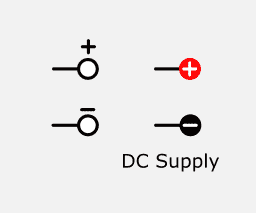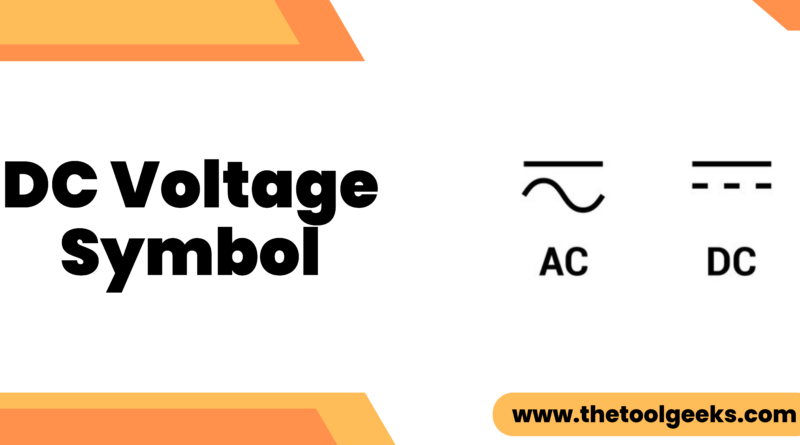Demystifying the DC Voltage Symbol: A Comprehensive Guide
TheToolGeeks.com is a participant in the Amazon Services LLC Associates Program and other affiliate advertising programs. We may earn from qualifying purchases. (Learn More).
In the world of electronics and electrical engineering, symbols are the language that professionals use to communicate complex ideas and concepts. Among these symbols, the DC voltage symbol holds a crucial place. Continuing our exploration of electrical measurements, In this article, we will explain the common DC voltage symbol, summarize its significance and how it applies to power tools.
What is a DC Voltage Symbol?
At its core, a DC voltage symbol is a graphical representation used in power requirements, electronic circuits and schematics to indicate the presence of a direct current (DC) voltage source.
The DC voltage symbol typically consists of a straight line with either a plus (+) or minus (-) sign, signifying the polarity of the voltage. Sometimes the DC voltage symbol also has 3 dashes under the straight line.
The Importance of DC Voltage Symbols
DC voltage symbols are the keys to understanding the flow of electricity within a circuit as well determining the power requirements of devices and tools.
Whether you’re troubleshooting electrical issues, analyzing an existing circuit, or simply trying to confirm the right voltage for your power tool, DC voltage symbols are your guiding lights in the world of electronics.
Commonly Used DC Voltage Symbols
Basic DC Voltage Symbol
The most fundamental DC voltage symbol is a straight line with a plus (+) or minus (-) sign, representing the polarity of the voltage. This symbol tells you whether the voltage is positive or negative.
Ground Symbol
The ground symbol, typically represented as a horizontal line with three downward-facing lines. It plays a role in establishing voltage levels within a circuit and is essential for ensuring the circuit’s safe and reliable operation.
Battery Symbol
A battery symbol resembles two parallel lines, one longer than the other, with a plus and minus sign at the ends, indicating the positive and negative terminals of a battery. This symbol is used to represent power sources in various electronic circuits.
Deciphering DC Voltage Symbols
Polarity
Polarity is a fundamental concept associated with DC voltage symbols. The inclusion of a plus (+) or minus (-) sign serves as an indicator of the voltage source’s electrical orientation. Polarity is crucial when connecting components in a circuit, as it determines the direction of current flow.
Voltage Levels
Alongside the DC voltage symbol, you often find numerical values that indicate the voltage level. This information specifies the strength of the voltage and helps in selecting appropriate components and ensuring safe operation.
Applications of DC Voltage Symbols

In Circuit Diagrams
Circuit diagrams are a common application of DC voltage symbols. These symbols are used to represent power sources, making it easier to understand the flow of electricity in a circuit.
In Electrical Schematics
Electrical schematics take circuit diagrams to a higher level of complexity, illustrating the connections and power sources within complex electrical systems.
Creating DC Voltage Symbols
Digital Tools
In the modern age, engineers often use specialized software to create precise and standardized DC voltage symbols for their designs. These instruments not only simplify the design procedure but also guarantee that symbols conform to established industry norms, promoting uniformity and precision within electrical diagrams.
Hand-Crafted Symbols
In certain situations, hand-drawn symbols may be used for quick sketches or prototypes. While less common in professional settings, hand-drawn symbols can still be valuable for conveying ideas during the early stages of a project.
DC Voltage Symbols in Real-World Circuits
Illuminating LED Circuits
Let’s explore a real-world example where DC voltage symbols come into play. Consider an LED (Light Emitting Diode) circuit. DC voltage symbols are used to indicate the power source that illuminates the LED. By understanding these symbols, engineers can design efficient and functional LED lighting systems for various applications.
Powering Complex Systems
In more complex systems, such as power supplies, you’ll encounter multiple DC voltage symbols representing different voltage levels and connections. These symbols are crucial for engineers to design and maintain power supply circuits that provide stable and reliable voltage to various components and devices.
Pinpointing Component Failures
When things go awry in an electronic circuit, troubleshooting becomes a crucial skill. DC voltage symbols are invaluable tools in this process. They help engineers pinpoint the source of issues by identifying faulty components or areas of concern. For instance, a missing or reversed DC voltage symbol can immediately signal a problem with the power supply, enabling swift corrective action.
DC Voltage Symbols and Power Tools
The DC Voltage symbol is important with power tools. It indicates the type of voltage that the power tool requires. Power tools that use DC voltage typically have a battery or a power supply that converts AC voltage to DC voltage.
The DC Voltage symbol is usually a capital V with three hyphens and a straight line on top. It is often found on the power tool itself, on the battery, or on the power supply.
Here are some of the reasons why the DC Voltage symbol is important with power tools:
- To prevent damage to the power tool: If you use a power tool with the wrong type of voltage, it could damage the internal components of the tool. This could lead to the tool malfunctioning or even breaking down completely.
- To prevent fire hazards: Using a power tool with the wrong type of voltage could also create a fire hazard. This is because the tool may not be able to handle the higher voltage, which could cause the tool to overheat or even catch fire.
- To ensure safety: By using the correct voltage, you can help to ensure the safety of yourself and others. Using the wrong voltage could create a shock hazard, which could lead to serious injury or even death.
Therefore, it is always important to check the DC Voltage symbol before using any power tool.
Wrap-Up
The Tool Geeks team hope you have enjoyed this article on DC voltage symbols and increased your electrical troubleshooting knowledge as a result.
Stay tuned with The Tool Geeks for the next article in this series on AC voltage symbols.
Amazon and the Amazon logo are trademarks of Amazon.com, Inc, or its affiliates.

